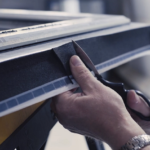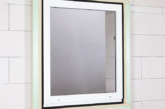Sealant tape specialist ISO-Chemie has been taking to the road to explain to architects and specifiers why keeping a tight seal on things is so important. PHPD’s Kieran Nee visited the company’s Air-tightness in Construction CPD at North London’s MEPK Architects to find out more.
As every housebuilder and developer in the UK knows, designing homes is as much about designing an efficient heating system as it is about anything else. In a country where heating bills constitute one of the largest outgoing expenses in the average home, it is paramount that new homes offer the conditions to maximise the comfort level achieved per pound. Indeed, comfort is king when it comes to housing.
This is why it can be so frustrating for new homeowners when, after having found what they thought was their perfect home, and laid down no inconsiderable sum of money, they find their home is perpetually cold, draughty and even potentially mouldy. Inevitably, more upset will come with the first utility bill.
 It’s no secret that efficient heating is at the forefront of the agenda by now, with debates about the most ecologically friendly way of heating homes sitting side by side (not always comfortably) with the outrage against rising energy bills. There is one solution, at least, which has proven wildly effective, comparatively cheap to enact and satisfies those on all fronts, and that is to ensure that the houses being built lose as little of their precious heat as possible.
It’s no secret that efficient heating is at the forefront of the agenda by now, with debates about the most ecologically friendly way of heating homes sitting side by side (not always comfortably) with the outrage against rising energy bills. There is one solution, at least, which has proven wildly effective, comparatively cheap to enact and satisfies those on all fronts, and that is to ensure that the houses being built lose as little of their precious heat as possible.
That is why ISO-Chemie, whose gap-sealing tapes and solutions provide effective resistance against heat loss, is doing its best to get the word out there by touring the country giving CPDs to architects and specifiers. The message is clear, not only are the right products needed for the job, but also the right installation. Hence the need to go beyond simple marketing and into the realm of education.
The initiative is intended to advance architectural knowledge and understanding of airtightness and related issues, enabling specifiers to improve the design and construction of buildings and boost their technical and product expertise. Unfortunately, thermal sealing around windows is not specified by law in the UK, unlike the rest of Europe, meaning that homeowners are at the mercy of specifiers and architects. How informed they are on the issue is a matter of great importance.
Delivered onsite and contributing towards formal CPD training, the programme covers advice on effective window installation techniques, and how to identify and rectify air leakage.
A large amount of heat is lost from a building through the gap between the windows and the surrounding wall, as thermal imagery clearly shows. This gap is necessary to allow for the natural expansion of the window frame throughout the year, what isn’t necessary, however, is the loss of heat.
 All on tape
All on tape
As CPD leader and Technical Adviser, Marc Barton explains, doors and windows account for 21% of the total air loss of the average house, and adding the joints between walls, floors and ceilings brings the figure up to 50%. Many argue that airflow is desirable, however Marc points out that you could easily eliminate 50% of heat loss whilst still retaining some natural air flow.
The statistics neatly illustrate that in most homes, those not built to Passivhaus standard, heat losses are overwhelmingly replaced by artificial heating rather than through solar energy or internal warmth. This means that reducing heat losses in the home is paramount in the battle to lower energy consumption.
One of the products Marc shows us is an expanding foam tape called ISO-BLOCO ONE, which sits between the window or door frame and the wall structure. This one tape fulfils three applications – providing defence against driving rain from the outside, offering thermal and acoustic insulation and creating an air-tight seal internally. As well as being BBA Certified, the tape also meets with Passivhaus standards, meaning housebuilders are assured of the best possible performance.
A big advantage of the tape is in the application process. It is applied to the window before installation, meaning that windows can be easily installed from inside the building, avoiding the need to use time consuming and costly external access systems like scaffolding and ladders. What’s more, the expanding foam contours to any shape or material to form a seal, creating a neat joint between the door/window and the fabric of the building, keeping your homebuyers warm and happy.





